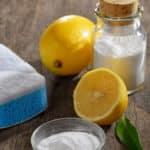How to Remove Blood Stains from Fabric
This post may contain affiliate links. Read my full disclosure here.
Accidents happen, and things get messy. We’ll share how to remove blood stains with common cleaners and pantry items, and the mistake you don’t want to make.

The Most Important Tips for Removing Blood Stains
The most important tips for removing blood stains are to keep the stain cool and treat it promptly. Don’t make the mistake of using hot water!
Blood is made of protein. Heat will set the stain, making it nearly impossible to get out. Don’t use hot water, or set the fabric in the sun, or throw it in the dryer until the stain is gone.
The quicker you can treat the stain, the better. Dried blood stains are much tougher to remove.
How to Remove Dried Blood Out of Fabric
For dried blood stains, soak the garment (or item) for 30 mins – 24 hours in cold water. Then try one of the ten proven methods to get rid of blood stains for good.
Before using any spot cleaning product other than water, pre-test fabric (see below).
Note: No matter how tough the blood stain you’re trying to get out, never mix chemicals. Chemicals that seem harmless when used alone can create deadly gasses mixed with other chemicals.
How to do a Pre-Test or a Spot Test
Find an inconspicuous area on the item, such as a seam or hem, by the zipper, on the underside of a chair. You’re testing to see if the color will fade or run/bleed.
To spot test:
- Wet a clean, white, lint-free cloth.
- Apply the cleaning product to the test area no bigger than a size of a quarter.
- Wait 10-15 minutes.
- Blot the test area with a clean white cloth and cold water.
- If color transfers to the cloth or bleeds stop.
- If the test area looks good, wait until it’s completely dry and examine again.
- You can opt to have it dry cleaned or try to use one of the other stain removing options.
1. Cold Water
Cold water is the first option you should try to remove blood stains.
- Dab the blood with a clean paper towel or napkin to soak up as much of the fresh blood stain as you can.
- Then run the stained area under cold water and repeat, as needed, until the stain is gone.
Make sure not to scrub the stain, just dab. Scrubbing will push the stain further into the fibers making it harder to remove.
2. Lemon Juice
Lemon juice is an acid that helps break down the enzymes and amino acids in blood. It also also helps whiten whites when used in the wash, so don’t use this method on dark clothes.
To use lemon juice to remove blood stains:
- Pre-soak the area in cold water
- Sprinkle the stain with baking soda
- Spray the baking soda with lemon juice
- Wait five minutes
- Use damp cloth to remove baking soda and lemon juice
- Wash in cold water with detergent

3. Hydrogen Peroxide
The number one recommendation to remove blood stains that you’ll find on the internet is hydrogen peroxide. For years, I kept a bottle of hydrogen peroxide in the bathroom to help remove period stains, and another bottle by the washing machine to remove blood stains from clothes before washing.
There’s just one problem with this (keep reading)…
Hydrogen peroxide works to help remove blood stains because it breaks down blood cells.
“Hydrogen peroxide (H2O2) is an oxidizer (or oxidizing agent). It reacts with the enzyme catalase (present in our blood), which catalyzes its breakdown and we end up with water, oxygen and heat.“
Sometimes the hydrogen peroxide reacts so vigorously that the heat produced may set the stain.
You can use hydrogen peroxide for stained fabric, but it’s not my first choice anymore. It’s wonderful to use on other non-fabric surfaces.
Much like lemon juice, peroxide will lighten colors, so do a test spot before using.
4. Oxi-Clean™
Oxi-Clean™ is a stain remover that is famous for removing tough stains, even dried blood, from fabrics. It’s considered color safe,meaning you can use it on colored fabrics without fading. Always follow the directions from the manufacturer.
5. Meat Tenderizer
Most meat tenderizers contains an enzyme called bromelain that is found in fruits like pineapple and papaya. Bromelain breaks down the peptide bonds found in blood.
Would you like to save this?
Experimental testing shows that meat tenderizer is effective in removing blood stains.
To use meat tenderizer to remove blood stains:
- Pre-soak the stain in cold water
- Sprinkle meat tenderizer over wet (rinsed in cold water) blood stain
- Scrub in powder (meat tenderizer) with an old toothbrush
- Let sit for two hours
- Launder in cold water
6. Salt
Salt is an absorbent mild abrasive, and can remove a variety of stains including grease, ink, rust, and blood.
To use salt to remove a blood stain:
- Pre-soak the stain in cold water
- Make a thin paste using salt and a little water
- Spread paste over the stained area
- Let set for 20-30 minutes
- Launder in cold water
7. Spit
Water, sodium, and amylase found in saliva helps remove blood stains. Just spit, rinse, and repeat. If you’re out camping and don’t have other options, try this tip.
Spit helps with grease stains too! Who knew?
8. Ammonia
Ammonia is good for treating a wide variety of hard to remove stains such as grass, urine, and blood.
To remove blood stains using ammonia
- Pre-soak in cold water
- Dilute a capful of ammonia with equal parts cold water
- Use a sponge to dab the ammonia mixture on the blood stain.
- Repeat until stain is removed
- Launder in cold water
9. Bleach (color safe) or Homemade Bleach
I only recommend using bleach for a blood stain if it’s on light colored fabric, even if you’re using color safe bleach. Regular bleach can weaken and damage fibers, cause holes, and yellow or discolor the fabric.
To remove a blood stain using homemade or color safe bleach
- Follow instructions under cold water from step one
- Mix 4 Tablespoons of bleach with ¼ cup of water.
- Apply bleach solution to the blood stain and let sit for 30 minutes.
- Launder as usual in cold water.
This homemade bleach recipe is cheap and non-toxic.
Homemade Bleach Recipe
- 3 Cups Water
- ½ Cup Hydrogen Peroxide
- 2 Tablespoons Lemon Juice 2 tablespoons lemon juice OR ½ teaspoon citric acid
10. Enzyme Detergent
Enzymes in laundry detergent act as a catalyst to break down what’s forming the stain so it washes away. Protease enzyme breaks down protein based stains.
Some common enzyme detergents include: Persil, Oxi-Clean, Presto!, or Arm & Hammer Bioenzyme Power Laundry Detergent.
To use enzyme laundry detergent to remove blood stains, presoak in cold water, and then follow the manufacturer’s instructions.
More Cleaning Tips
For more natural cleaning tips, see:
6 Ways to Get the Musty Smell Out of Clothes and Towels
Best Odor Eliminators for the Refrigerator, Freezer and Carpets and More

This post is by Amber Bradshaw of My Homestead Life.
Amber and her family moved from their tiny homestead by the ocean in South Carolina to forty-six acres in the Smoky Mountains in East Tennessee.
They filmed their journey for a TV show called Building Off The Grid: The Smokey Mountain Homestead.



The meat tenderiser solution seems to be a perpetuating myth. After buying and trying the tenderiser, and so sure it would work because this wonderful solution is all over the internet, I was disappointed in a totally failed result. I understand how this myth began. Tenderiser has papain in it, which is an enzyme from papaya, but the papain is just 1% of the total ingredients. I subsequently bought some cleaner from a supermarket and it worked. I won’t name the product because my comment might read like an advert.
As a retired RN, I swear by hydrogen peroxide. I have never had it set a stain. I do recommend a spot test tho, as it can ‘bleach out’ darker colored materials. Agree 100% with using cold water as well.